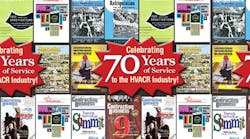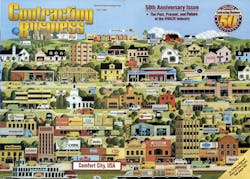The 1940s was a decade that began in the deepest depression the world had ever seen and ended in previously unimaginable growth and prosperity.World War Two began a shift in demographics from the farm to the city. In its aftermath, the American population grew exponentially. We became better educated and our newfound growth and prosperity offered amazing opportunities for the refrigeration and fledgling comfort industries.
It was against this backdrop, in June 1944, that The Refrigeration Industry magazine was born in Cleveland, Ohio, where we remain to this day.
In those days, refrigeration was something that began showing up in manufacturing facilities and movie houses. In fact, the refrigerants were much different than what we find in use today: sulfer dioxide and methylene chloride were the refrigerants of the day, and the new kid on the block was this unknown chemical that went by the trade name of Freon.
It’s interesting to note that the adoption of Freon took longer than, perhaps it should have, because of the shortage of cylinders with which to store and transport it. Who knew back in the 1940s how important Freon (R-22) would become and the impact of the international rules that eventually outlawed its use.
In 1949, The Refrigeration Industry’s name was changed for the first time since its inception to Commercial Refrigeration and Air Conditioning. The change was made to reflect the growing importance of commercial air conditioning as a necessity instead of a luxury. Some might say the name change foretold the growing importance of air conditioning to the point where it surpassed refrigeration as a market force.
Over the years, the magazine continued its evolution as the market changed. It underwent a number of name changes during its evolution. These include:
- Refrigeration and Air Conditioning Business — 1958
- The Air Conditioning and Refrigeration Business — mid-1960s
- Contracting Business — 1981
- Contracting Business.com — 2009.
Over those seven decades, we covered and were on the forefront of covering topics ranging from value engineering to Design/Build, witnessed the industry change with the development of electro-pneumaic controls, and then watched it change again with the development of wired/wireless controls, and direct digital controls.
In the 1950s, the use of air conditioning in hospitals became more prevalent — mostly to ease the healing of wounded soldiers from the Korean War, but eventually to help in the healing of everyone. By the end of the decade air conditioning began to move toward centralized systems. We also began seeing the first supermarkets.
In the 1960s, the U.S. was undergoing tremendous economic growth and violent change. It was in 1965 that the phrase, “Total Comfort System” was coined, first by Westinghouse, then by Lennox. This decade saw the introduction of district heating technologies, and commercial HVAC systems grew bigger and more complex. Obviously the role of HVAC contractors became central to the installation and maintenance of these systems.
The 1970s and 80s brought about the first oil crisis that made energy efficiency the driving force behind both engineering and marketing efforts. The Department of Energy was created and began making policies that still impact the HVAC industry today. The industry went from construction boom to bust, saw the birth of the gigantic replacement market, and the computerization of business — changing forever how contractors operated in the marketplace.
The 1990s and 2000s were the eras of the information age, the Internet, and cloud-based technologies, economic recession, and slow growth. It’s been an incredible ride.
Thanks for letting us serve you then AND over the next 7 decades.













